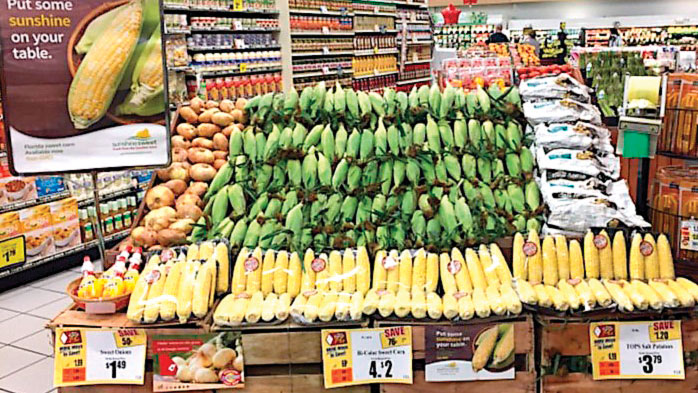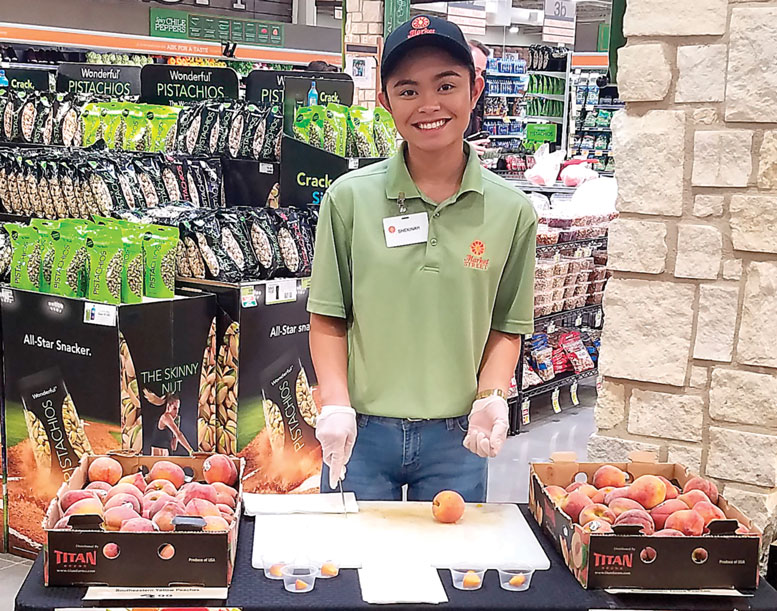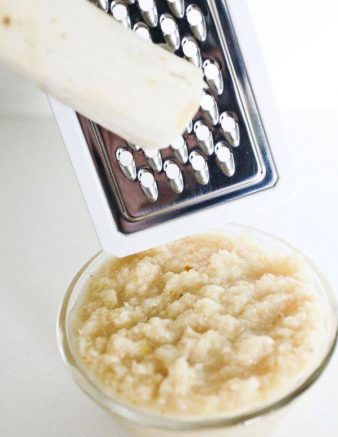Spring Merchandising Guide: Maximize Sales By Spotlighting New Crops and Holidays
March 4, 2021 | 13 min to read
As spring approaches, retailers are urged to proactively showcase seasonal produce like spring berries and Vidalia onions well before peak harvests. Early promotions capitalize on holidays such as Easter and Memorial Day, while digital marketing efforts help engage consumers. Successful strategies include highlight displays, price promotions, and social media updates, enhancing impulse purchases of items like Florida peaches and artichokes. Retailers are encouraged to leverage food trends and educate consumers about seasonal produce to boost sales effectively.

Retailers are encouraged to get out in front of consumers early, even before the full-fledged harvest comes to a peak.
Originally printed in the February 2021 issue of Produce Business.
As winter departs and spring arrives, holidays roll through with the changing weather and create promotional opportunities that can help buoy sales through the season. Starting in the Easter/Passover space and continuing through Memorial Day, the occasions are marked by changes in available produce, which helps establish the range of opportunity.
Of course, many fruits and vegetables that once were strictly seasonal are available year around today. Yet, many consumers look forward to seasonal fruits and vegetables, and even anticipate their arrival as enticements to switch up the meals they eat. These seasonal prompts are important for retailers as well, as spring is always a time of rebirth within the produce department, where new displays of spring berries, sweet corn, artichokes, Vidalia onions and many items associated with Passover, Easter and St. Patrick’s Day meals go on shopper lists.
Retailers that get spring seasonal produce out in front of consumers early, even before full-fledged conversion of seasonal displays, can get consumers at least thinking about purchasing. They also can support seasonal produce through conventional circular marketing and by taking advantage of digital marketing vehicles, such as social media, that can stir interest in what the store holds.
Douglas Preston, president of the Union Grove Piggly Wiggly, Union Grove, WI, says early spring holiday merchandising and promotion is a confluence of dynamics. First, as a franchise operations, Union Grove Piggly Wiggly has the parent company’s promotions to place and build on. At the same time, the produce that is beginning to roll in from Mexico and Florida helps to define how his store approaches the Easter/Passover season. As the seasonal produce rolls in and prices decline with the abundance, and seasonal displays change over, the store is ready for the initial holiday period and for spring activities.

“The advertising follows the season,” Preston says. “In produce, we might have been carrying strawberries for $5.99, and when they become more available, they might run at $1.99.” At the same time, as major regional growing areas come on line further and further north as the season progresses, the store can focus on new factors in its seasonal produce sales on the way to Memorial Day.
“A good example is sweet corn,” Preston says. “We first start getting the shipments from Mexico and Florida. As the season progresses, it comes up North, and, by the time it gets to Illinois, we start getting the local corn in.”
GET THE WORD OUT
A concerted effort to spread the news about what’s arriving is important. Small retailers and large are using social media to boost holiday sales. Bargain Grocery in Utica, NY, has been using social media to continually update consumers on the produce it has in store, with a particular emphasis on what’s new seasonally and what it brings in and sells through in the course of its own purchasing cycles. It also tips consumers on what might be arriving. So for last year’s Memorial Day, for example, Bargain Grocery created a Facebook post spotlighting a new, featured merchandising presentation of cherries among several other items, but it also tipped the arrival of Georgia and other eastern peaches, piqueing consumer interest with the idea of generating more store visits.
“Our social media following is huge,” says Rachel Daughtry, Bargain Grocery director of agency relations, who develops and designs all the digital and creative content for the company. “As soon as new product comes in and hits on our social media pages, customers stream in almost immediately. It’s a direct connection to our customers, and we’ve been really fortunate to see our sales steadily increase with our social media presence.”
Tori Rumenik, executive director of the Sunshine Sweet Corn Farmers of Florida and commodity service supply chain manager at the Florida Fresh Fruit and Vegetables Association, Maitland, FL, says spring promotions “do center around Easter and Memorial Day.”
Still, retailers would do well to take the long view when it comes to sweet corn promotion, she suggests, by maintaining dedicated everyday merchandising while building up to holiday occasions. Although the holidays are important, Rumenik points out that too tight a focus on the actual dates can short-change opportunity. The lead up is critical, she says, focusing consumer minds on the product not only to get the purchase prior to the holidays but also to get shoppers into the habit of purchasing seasonal produce so they include it in their meal planning for the big occasions as they roll around, as is in the case of, say, Memorial Day.
“We don’t always run promotions up to Memorial Day,” she says, “But if we run promotions in the weeks up to Memorial Day and have them out before, it reminds consumers about the day. Then, Memorial Day takes care of itself.”
For Ocean Mist Farms, Castroville, CA, spring is a time to shift emphasis on artichokes and execute a spring strategy that revolves around encouraging consumers to take a new look at the vegetable, says Diana McClean, senior director of marketing.
“While Ocean Mist Farms artichokes are grown year-round, our Gold Standard Castroville artichokes, which we are most known for, are harvested in the April/May time frame each year. We also have a special artichoke variety that will be ready for shipping in the early spring, purple artichokes. Ocean Mist Farms is supporting retail sales for the purple artichokes with a variety of marketing activations centered on the unique variety and short season,” McClean says.
Ocean Mist has an annual spring promotion for its Gold Standard artichokes in April, which is focused on in-store product merchandising, but this year, it will have a precursor. “In March, we’ll be promoting our purple artichoke variety that is available for a very limited time,” McClean says,”followed by the Gold Standard promotion in April.”
Ocean Mist is working to give consumers a broader picture about artichokes and when they might incorporate them into their meal planning, but spring is a critical time to reach the public. “Because shoppers tend to think artichokes are primarily a spring vegetable — unfortunately, we still see food media perpetuating this falsehood — we do see above-average volume sales during several weeks throughout the spring,” McClean says.
Few vegetables are more closely associated with spring than are Vidalia onions. Even though that is the case, retailers are best served if they press the advantages that spring provides, says John Shuman, president and CEO of Shuman Farms, Reidsville, GA.
“We recommend retailers focus on the importance of seasonality, spring and summer holidays, and consumer trends during Vidalia season,” he says. “For example, we are seeing the topic of ‘meal planning’ driving search inquiries, therefore we recommend retailers create meal solutions that include Vidalia onions and other items from the store, like peppers, mushrooms, tomatoes, etc.”
He adds that consumers wait eight months for Vidalia onion season, so retailers should consider getting the item some profile early on. Then it’s a matter of adjusting through time and to consumer preferences.
GO BIG IN SPRING
In merchandising, conspicuous, abundant presentations that alert consumers to the presence of spring fruits and vegetables remain critical both to trigger impulse sales and get shoppers thinking about adding them to shopping lists.
The traditional method of crate display continues to be effective in merchandising sweet corn, Rumenik says. Some retailers do promote packs but the “majority of promotion is going to be bulk corn in crate.”
Price promotion is important to bolstering display initiatives, she advises. Retailers need to find a sweet spot in their approach to the consumer, whether it’s six ears for a dollar or something akin to that, to maintain sales volume. Holidays are a good time to push the pedal on deals as people get together in celebration.
Shuman says retailers can make the most of Vidalia onions by spreading them around. “Based on our consumer research, we know that merchandising Vidalia onions throughout the produce department is important to maximize sales,” he maintains. “Shuman Farms offers full-color, high-graphic secondary display bins that can be easily placed not only in the produce department but also the meat department offering customers the perfect add-on item.”
New or at least earlier-shipping fruits and vegetables provide retailers with additional opportunities but, to integrate new seasonal crops for promotion, they need to gauge department sizes and how they can divvy up space to best effect, with product movement potential a determinant.
Sonia Tighe, director of membership at the Florida Fruit & Vegetable Association and executive director of the Florida Specialty Crop Foundation, Maitland, FL, points out, “The Florida peach season runs late March through mid-May. It is the first domestic peach produced in the season. With the Florida varieties that the University of Florida has developed, we have a very sweet and juicy peach that is the perfect size for snacking or using in recipes.”
A Florida peaches shipper, Daryl Johnston, vice president of sales for Titan Farms Sales, Ridge Spring, SC, says, “We want to ensure displays are not too big for the store’s pull, so we make sure we work very closely with our partners. Talking with the retailer is a great way to provide the right guidance. Cross promotions are excellent ways to give Florida peaches more visibility and excite customers. We also recommend small displays outside of the produce department to increase impulse purchases.”
Efforts to back up promotions with visible merchandising in-store can be especially rewarding with items that already have a unique look, such as Ocean Mist purple artichokes in March.
“Visually, the artichokes at retail look great,” McClean says.
Creativity and an eye toward consumer concerns can give retailers an additional boost. Bargain Grocery emphasizes nutrition information, but it does more than many by continually updating what it provides consumers as new items roll into the store.
“We really focus on the nutritional education piece,” Daughtry says. “We release new recipe videos weekly to engage customers, but also educate them on simple, healthy ways to add more veggies or create healthier dinners for themselves and their families. We have created seasonal veggie educational cards that customers love. We place them next to the veggies that we want to highlight. They are esthetically pleasing, and informational. We focus on five to six ways to use each veggie. Fun, creative, and engaging.”
FRESH FLAVORS
As seasonal products become available in the spring, Bargain Grocery will draw attention to growing regions and their reputations for particular fruits and vegetables as a call to purchase at the peak of freshness.
“People really want to know where their food is grown,” Daughtry says, “and our customers especially flock in when growing season starts for produce.”
The opportunity to use growing regions to tell a story becomes a way to engage consumers and, potentially, get them to try something new.
Titan Farms Johnston says, “We call peaches a summer fruit, but now that we have Florida peaches, we are getting people excited sooner and extending the season.”
The evolution involved can give savvy retailers a jump on seasons and a way of keeping displays fresh as the weather warms.
“Consumers are looking for items that give the feeling that spring/summer is here, and Florida peaches really fit the bill,” Johnston says. “They are the first domestic peaches of the year, and the flavor makes you feel like summer is already here. Conspicuous displays are important especially for impulse purchases and drawing customers in. Promotions will depend on crop size and, if available, we do like to promote in addition to building the displays.”
Dennis Diekemper, operations manager of horseradish grower J.R. Kelly Co., Collinsville, IL, notes that, when it comes to spring seasonal produce, a group of consumers that retailers should keep in mind is the expanding and evolving cohort of foodies.
He points out that self-identified foodies have been a growing group of consumers who, over the past year, have been cut off from the restaurants and takeout joints that were part and parcel of their pursuit of food trends. Left largely on their own by coronavirus-related movement restrictions, foodies have been looking to prepare what they once purchased. However, in supermarkets, they are confronted with a lot of processed products many of which have preservatives, which generally turns them off. So seasonal fresh items are in their wheelhouse both from an authenticity perspective and because they provide an opportunity to explore new dishes.
Horseradish is among those items that at least some foodies have discovered and employed in their cooking. “With people being at home nowadays, they’re looking for something new to try and prepare, and now that includes fresh horseradish,” he says.
The advantages are several. For one thing, handled properly, fresh horseradish will hold its heat longer than processed. Because consumers can store horseradish root for a couple of months without losing flavor, they can experiment with it as a condiment on many dishes from fresh ham to salad. J.R. Kelly includes recipes on its website that retailers can tap or reference to entice consumers about the novel advantages horseradish brings to food prep.
Spring Holiday Promotional Opportunities
Horseradish is often associated with Passover and its use as a bitter herb showcasing dishes for the occasion, but a range of consumers these days have come to appreciate it for its flavor and accessibility.
Dennis Diekemper, operations manager for J.R. Kelly, says Passover continues to be the major holiday occasion for horseradish but adds, “Easter is just as big now.”
Although its use may continue in the Passover context with the greens attached, horseradish has additional applications that anyone can appreciate. The attraction is especially strong for foodies who are constantly looking for new ways to add excitement to cooking, he says. Not only that, but cocktail connoisseurs can use horseradish in cocktails for some extra punch.

Easter, Mother’s Day and Earth Day are also spring holidays high on the list for important produce promotions. “For Easter and Mother’s Day, Fresh Del Monte recognizes the importance of gathering family together for celebrations,” says Pablo Rivero, Del Monte vice president of marketing, North America, Coral Gables. “For these types of occasions, Fresh Del Monte annually highlights vegetable party trays, which include a host of freshly cut vegetables such as broccoli, cauliflower, sliced bell peppers, grape tomatoes and sugar snap peas.”
Additionally, Del Monte encourages consumers to “think pink” this Mother’s Day and give the one-of-a-kind “Jewel of the Jungle,” Pinkglow pineapple. “Grown in the Costa Rican jungle, this exotic pineapple acts as a unique and creative gift that will wow mothers this Mother’s Day,” says Rivero.
As for Earth Day, Rivero says Del Monte commits to planting and/or donating 2.5 million trees by 2025, in addition to the 864,167 trees planted since 2016.”
When Cinco de Mayo rolls around, US shoppers start thinking about festivities with a little more spice and getting outdoors. If not exactly seasonal, guacamole certainly gets a lift in profile during a Cinco de Mayo holiday that is getting more broadly celebrated across the United States.
Del Monte has relaunched its Homestyle Guacamole in a variety of new flavors in plenty of time to establish the product range for Cinco de Mayo and grilling season.
“As one of North America’s leading marketers and distributors of high-quality fresh and fresh-cut fruit and vegetables, Fresh Del Monte has ensured its revamped Homestyle Guacamole pays homage to authentic Mexican guacamole,” says Rivero.
“Available in a variety of new flavors such as Jalapeño & Tomato, Classic Lime & Garlic, Mango & Lime and Black Bean & Corn, Fresh Del Monte’s high-quality ingredients incorporate the fresh taste and texture of a homemade guacamole without the hassle, perfect for a delicious and authentic Cinco de Mayo.”
In addition to its own efforts, Del Monte is cooperating with retailers to boost the promotional opportunity associated with the holiday.
“For this upcoming Cinco de Mayo, Fresh Del Monte is working closely with a handful of retailers to create a program consisting of coupons, recipes and digital adverts,” Rivero says. “We are also partnering with local and national influencers to generate brand awareness surrounding our product offerings to complement any Cinco de Mayo celebration. The brand is also looking to launch a new modular display at select retailers to better showcase its avocado selection ahead of the holiday. We find it essential to keep moving various products in and out of focus, so each produce piece gets some time in the spotlight.”
7 of 11 article in Produce Business March 2021

